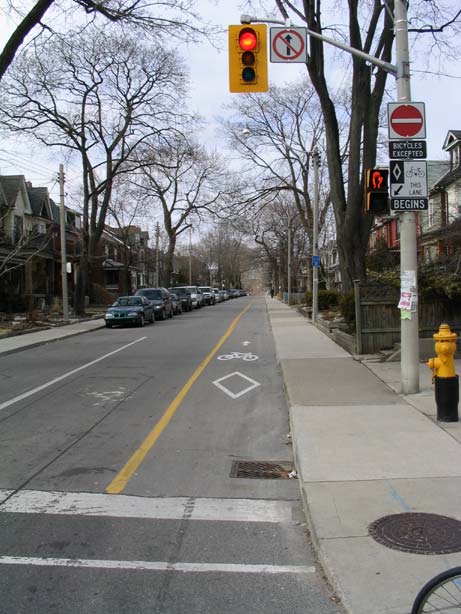Bicycle Lane Futures

This is Harbord and Montrose in the west end of Toronto. It’s a marked bicycle lane going the opposite way on a one way street. It’s a fantastic solution to the plethora of one way streets that dominate the old inner city neighbourhoods of Toronto – streets that are organised in a deliberately directionally discontinuous manner to prevent traffic short-cutting through residential streets since most of the inner city was built on a relatively regular grid. Unfortunately, this organisation of one-way streets makes life difficult for bicycles trying to obey the traffic laws – so let’s face it, most of us frequently cheat and go the wrong way down one way streets. And of course we always stop at stop signs too, right?
Now call me a shit-disturber, but I can’t help think that instead of making “a bicycle expressway along Bloor/Danforth” (um, what did we build that subway line for?), we should improve the ability of cyclists to legally penetrate the city’s network of one way streets through schemes such as this one. There’s even a special traffic light at Bloor at the north end of Montrose with a bicycle-only green light.
Despite commuting to work every day by bicycle, I have to say I’m not a fan of normal bike lanes – these ones improving access to the city being an exception. The reason I feel this way is that bike lanes foster the impression that cars and bicycles can’t really share the roads – that bicycles in fact need their own lanes. Sure, that means they’re sharing the asphalt – but I worry that it means in the long run that drivers won’t be used to sharing their every day roads with cyclists. In european cities where bicyclists are supported with vast networks of bicycle lanes, this is almost my impression – that once you accept that bikes need their own space, you can’t stop – all of a sudden every new road needs a bike lane, every major road – in fact european bike lanes are frequently off the road entirely which is not exactly sharing the road, is it? It’s avoiding it.
The flip side to that concern is that bike lanes prevent cyclists themselves from acclimatising to sharing the road with other traffic – leading to a sense of confidence which, while theoretically desirable, is not based in the safety reality of urban cycling. Apart from the joys I find in weaving between traffic and demanding my own space on the road without an official line to decide the matter, it concerns me that too many bike lanes make it too easy for people who are not ready for city cycling to believe that it’s safe for them to cycle.
The first car you find “standing” in a bicycle lane, forcing you out into a traffic lane you’re not supposed to be in, might get you concerned. Then as you look back to talk to your friend who’s following you in your “safe” bike lane, someone in front gets out of their parked car without looking, stepping right into the lane and forcing you to either slam your brakes on, or again swing out into traffic to avoid them – that is if they didn’t hit you with their door in the first place. Further along, you come up behind a bus which, every time it comes to a bus stop, swings over into the bike lane, forcing you to either trail along behind it (breathing it’s lovely diesel fumes – a bus stopping at every stop moves along at just the right speed to keep in front of a cyclist – if you try to pass it, usually it passes you and cuts you off at the next stop) or swing back out into a traffic lane.
These are things that happen to me every time I use a bicycle lane. These are the realities of urban cycling. But in all of those cases, the bicycle lane is actually exasperating the problem – making the violation more of an affront than it otherwise would be because the cyclist believes that they have a “right” to that lane. While that may be the “right” thing, to me that kind of attitude leads to less safe cycling – rights don’t mean anything at the moment of contact between a 1 or 2 ton vehicle and a poor little cyclist. And you can always rely on other traffic to constantly violate the “safety” of bike lanes. Urban cycling is dangerous. Will more bike lanes along all of the busiest streets in the city make this better? I doubt it. Why are we encouraging cyclists to use the busiest streets in the city in the first place?
Instead let’s make it easier for cyclists to legally move through the quiet residential streets of the city – creating their own shortcuts to every destination imaginable. Bike lanes should be reserved for the most dangerous and problematic sections of road. And for those who don’t want to cycle without bike lanes? That’s what transit is for. Whether it’s about getting bike racks on buses and streetcars, or accepting that transit really is the better way, and despite using a bicycle pretty much every day (yes, all winter too), I increasingly feel that cycling as a means of transportation in the city (rather than as a form of recreation) is not, and will never be, for everyone.
